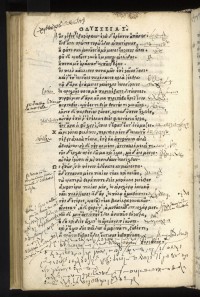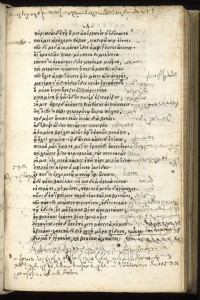 On April 24th, the University of Chicago Library announced a contest to decipher mysterious margin annotations in a rare edition of Homer’s Odyssey printed in Venice by Aldus Manutius in 1504. This was only the second edition of the Odyssey in Greek ever printed (the first was published in Florence in 1488) and this particular example passed through many hands, several of which left marginalia in various languages on the pages.
On April 24th, the University of Chicago Library announced a contest to decipher mysterious margin annotations in a rare edition of Homer’s Odyssey printed in Venice by Aldus Manutius in 1504. This was only the second edition of the Odyssey in Greek ever printed (the first was published in Florence in 1488) and this particular example passed through many hands, several of which left marginalia in various languages on the pages.
The two-volume book is part of the Bibliotheca Homerica Langiana (BHL), a collection of rare early print editions of Homer’s works that was donated to the library in 2007 by Michael C. Lang. Lang had noticed that in the second volume of the 1504 edition there were handwritten annotations that had some French words mixed in with what looked like a shorthand. Researchers at the library weren’t able to crack the idiosyncratic script, so they opened it up to public at large with a $1,000 reward offered by Lang for the first person to identify and translate the code. People from all over the world responded to the challenge.
Less than two weeks later, we have a winner. The feat was accomplished Daniele Metilli, a computer engineer, archival science student and general lover of cyphers, with the help of French speaker and stenographer Giulia Accetta. He’s in Italy and couldn’t make a trip to Chicago to view the book in person, so the library sent him high resolution images of two pages from Book XI of the Odyssey that have the annotations in question.
 Because the shorthand was mixed with French and because one of the notes contains a legible date of April 25, 1854, Metilli and Accetta started by investigating French shorthand systems that may have been in use in the mid-19th century. The earliest French shorthand methods were created in the 17th century, one by Jacques Cossard in 1651, the next by Charles Alois Ramsay in 1665. Neither of those systems matched the one in the Odyssey. They then turned to 19th century systems but none of those worked either.
Because the shorthand was mixed with French and because one of the notes contains a legible date of April 25, 1854, Metilli and Accetta started by investigating French shorthand systems that may have been in use in the mid-19th century. The earliest French shorthand methods were created in the 17th century, one by Jacques Cossard in 1651, the next by Charles Alois Ramsay in 1665. Neither of those systems matched the one in the Odyssey. They then turned to 19th century systems but none of those worked either.
It was an appendix in a 1792 book on stenography by Théodore-Pierre Bertin that pointed them in the right direction. The appendix included a table that compared a stenographic system invented by Samuel Taylor in 1786 to a “tachygraphy” (from the Greek word for “swift”) system for the French language invented by Jean Coulon de Thévenot in 1776. The notes in the Homer edition looked very similar to the tachygraphy in the table. Metilli and Accetta located a copy of Thévenot’s manual Tachygraphie des Français, an 1819 edition of Tachéographie ou Tachygraphie française by stenography professor N. Patey and two mid-19th century French translations of the Odyssey and got to work.
In Thévenot’s system, “every consonant and vowel has a starting shape, and they combine together to form new shapes representing syllables,” Metilli wrote. “The vertical alignment is especially important, as the position of a letter above or below the line, or even the length of a letter segment can change the value of the grapheme. This explains why most notes in the Odyssey shorthand are underlined—the line being key to the transcription.”
 They were able to translate almost of all of page A and some of page B. The mysterious marginalia are French translations of Greek words and phrases, questions about the text, definition comparisons, corrected errors, the kind of notes someone who was studying Greek would take. Most people wouldn’t scribble their notes in the margin of a very rare, very expensive 1504 edition, however. Why not get a cheap mass market contemporary edition if you’re going to write all over it? Also, most people in 1854 weren’t using shorthand that was popular 50 years earlier. Cracking the code has yet to solve the mystery of who this eccentric annotator was.
They were able to translate almost of all of page A and some of page B. The mysterious marginalia are French translations of Greek words and phrases, questions about the text, definition comparisons, corrected errors, the kind of notes someone who was studying Greek would take. Most people wouldn’t scribble their notes in the margin of a very rare, very expensive 1504 edition, however. Why not get a cheap mass market contemporary edition if you’re going to write all over it? Also, most people in 1854 weren’t using shorthand that was popular 50 years earlier. Cracking the code has yet to solve the mystery of who this eccentric annotator was.
In his report (pdf) on the deciphering of the marginalia, Metilli proposes three possible hypotheses: 1) the notes were written by a student, 2) by a teacher, 3) by a translator. If 1) were correct, you’d expect there to be more unnoticed errors in the notes. The other two possibilities would explain the competence of the translation, and 3) would be quite likely to be familiar with shorthand systems.
Metilli then had a bit of a coup de foudre:
The main edition of the Odyssey we used as reference was translated by Édouard Sommer and published by Hachette book by book starting in 1848. While transcribing the shorthand, we had noticed how the annotations sometimes seemed to use the exact same wording as the “argument analitique” found in that edition.
The Sommer translation is very accurate and close to the text, just like our annotations. The other translations of the time (Bareste, Leconte de Lisle) look nothing like it. So it finally came to me: which year did Hachette publish book XI of the Odyssey? Which year did the annotator write his notes? The same year: 1854. What if Mr. Sommer were our mysterious annotator?
Sounds downright plausible. It still doesn’t explain why in the world he used the Manutius edition, of course, but that’s some quality Nancy Drewing right there. One thousand dollars very well deserved.
I know from the wonderful responses to the World War I shorthand post that we have several shorthand pros in the house. Be sure to check out Metilli’s report because there are all kinds of details about the system and translated passages in there. You don’t have to read French to enjoy it.
Thrilling!
Fascinating post – top-notch blog!
Manutius texts weren’t as costly then as they are now. Nor, I expect, viewed quite as reverently.
On the other hand, those texts were no doubt more generally read then than they are now.
Name me that man, oh Mousa, who scribbled misterious shorthand
French annotations for years among incomprehensible siblings
Be very aware, oh Goddess, that tumbling verse won’t stop a true hero
—————-
P.S. Oh, Mousa, I hope that the lines are broken correctly
Darn. I had my money on “Loaf of bread, gallon of milk, stick of butter.”